What size mountain bike frame do I need? That’s one of the most commonly asked questions by our readers.
Ordering bikes online is becoming more and more popular. Bikes are typically more affordable online than in local bike shops because overhead costs are lower, allowing online stores to sell their bikes at cheaper prices.
But what about the good old rule that says you need to try a bike before buying it? While this can be beneficial, it’s often an overrated method and not necessary for everyone.
If you go to a local bike shop and sit on a bike, you’re more likely to buy it, which is why shopkeepers would like you to do it. But the reality is that most novice riders don’t know how a bike should feel during their first test ride, so this sizing method is not valuable for inexperienced riders.
You should try your bike first! Not completely true!
Even though everyone is built differently, most people’s bodies fall into certain categories in terms of height, inseam length, and arm length. Therefore, unless you’re have an unusual ratio of upper and lower body length, you can trust mountain bike size charts to recommend you the right frame size.
Related: Best Mountain Bikes You Can Get
With that in mind, there are several reliable methods to choose the right mountain bike frame size.
In this article, I’m going to show you how to use mountain bike size charts and online calculators to get the right size and fit in seconds!
Contents
Method #1: Mountain Bike Size Chart
The easiest way to find the correct bike size is by using a mountain bike frame size chart. This is a simple method that lets you compare your height and/or inseam length against a chart that recommends the correct frame size.
Mountain bike frame sizes are measured based on seat tube length, expressed in inches, which typically ranges from 13″ to 24″. Effective top tube length (the horizontal distance between the head tube and the seat tube) plays a role as well, but seat tube length is a more common measurement.
Some manufacturers also use size classes, such as XS, S, M, L, and XL, but these are not as reliable as using inches because the measurements can differ from one brand to another.
What mountain bike frame size do I need? Find the answer in the chart below:
| Rider Height | Suggested Mountain Frame Size | ||
| Feet & Inches | Centimeters | Frame Size (inches) | Size Classes |
| 4’10” – 5’2″ | 148cm – 158cm | 13″ – 14″ | X-Small |
| 5’2″ – 5’6″ | 158cm – 168cm | 15″ – 16″ | Small |
| 5’6″ – 5′ 10″ | 168cm – 178cm | 17″ – 18″ | Medium |
| 5’10” – 6’1″ | 178cm – 185cm | 19″ – 20″ | Large |
| 6’1″ – 6’4″ | 185cm – 193cm | 21″ – 22″ | X-Large |
| 6’4″ – 6’6″ | 193cm – 198cm | 23″ – 24″ | XX-Large |
Bonus tip: If you’re buying a bike on Amazon, you can also check out their Amazon Fit Guide which includes sizing recommendations for adult road bikes, adult mountain bikes, and kids’ bikes.
Related: Best Gravel Bikes You Can Buy
Method #2: Online Bike Size Calculator
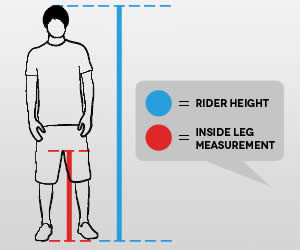 The next best way to find the right mountain bike size based on your height and inseam length is to use an online bike size calculator.
The next best way to find the right mountain bike size based on your height and inseam length is to use an online bike size calculator.
These are interactive tools that let you enter your height and inseam length and then recommend you the correct size or range of sizes to consider.
Before you can use one, you need to learn how to correctly measure your inseam. Here’s a quick step-by-step guide:
- Take off your shoes and stand with your legs 6″ to 8″ (15-20 cm) apart.
- Place a book between your legs, as far up as you can.
- Measure the length from the ground up to the top of the book.
- Voila! This is your inseam length that you can now enter into an online bike size calculator.
When using a bike size calculator, make sure to choose the right type of bike—mountain bike, city bike, or road bike—as the measurements will differ based on that.
If you’re not sure about it, you can read more about the different bike types here.
Here are the top online bike frame size calculators we recommend:
1. Ebicycles.com Online Calculator: An easy way to find the right MTB frame size by using your height and inseam length.
2. Competitive Cyclist Fit Calculator: A more detailed bike fit calculator that lets you know the correct standover height range, top tube length, saddle height, and more.
3. Jenson USA Bike Fit Calculator: Another in-depth bike fit calculator that suggests the right bike size and helps you nail the fit afterward.
Method #3: Mountain Bike Sizing Formula
One of the easiest but also the least reliable methods of finding the right mountain bike size is using a simple mathematical formula that uses your inseam length.
It goes like this:
Leg inseam (cm) x 0.66 = Your frame size
For example, if your leg inseam is 76cm, multiplied by 0.66 then your correct mountain bike size is 20″ (50cm).
This method is only good for approximating the correct size, but we don’t recommend relying on it exclusively. It’s best to combine it with the results you get from the mountain bike size chart and online calculator that we’ve shown you above.
Bonus Tip: Finding the Right Saddle Height
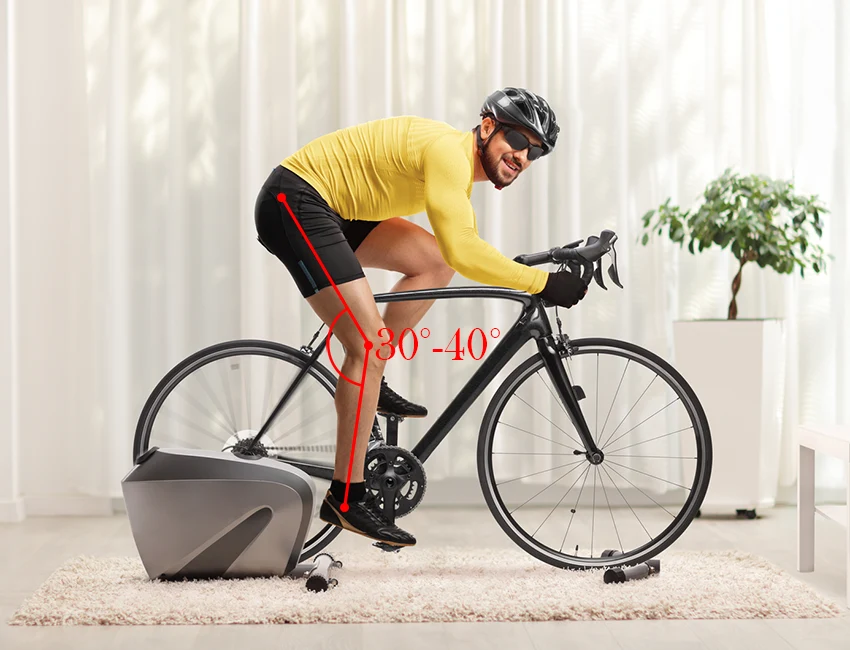
Setting the saddle height correctly has a very important impact on the overall bike fit.
If the saddle height is too low, you won’t be able to transfer power to the pedals effectively and your legs may fatigue more quickly. I have experienced that firsthand in mountain bike racing—when the saddle falls down by one inch from its ideal position, I lose about 25-50% of my power.
Now that we know how important finding the perfect saddle height is, how should we do it?
The easiest way is to:
- Hop on your bike wearing the shoes that you typically use for cycling (flat or clipless).
- Lean against the wall for support or have someone help you stay in an upright position. You can also use a bike trainer for this purpose.
- Push the pedal down to its lowest point (6 o’clock) while keeping the foot parallel to the ground.
- At this point, you should have a slight bend in the knee, as shown in the image above. Adjust the saddle height accordingly until you achieve it.
The next step is to go outside and ride. Does it feel good? If not, then make further minimal adjustments (a few millimeters at a time) until the saddle height feels natural, your power transfer is optimal, and you’re not feeling any pains or aches.
Related: Check Out The Best Fat Tire Bikes
 Bicycle Guider’s TIP:
Bicycle Guider’s TIP:
Once you’ve determined your ideal saddle height, it’s a good idea to mark that position with a marker, as saddles can lower with time. Some bikes come with height indicators on the seat post, so make sure to remember the correct marking for future reference.
MTB Geometry Guide
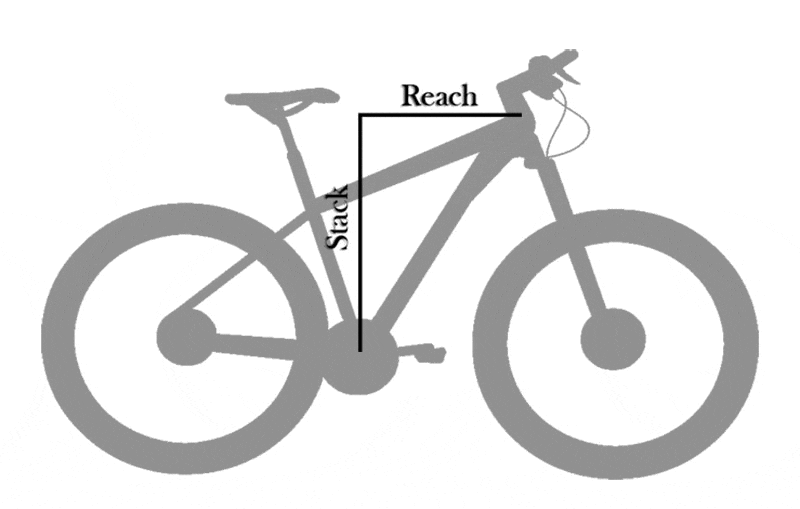
Mountain bike geometry refers to the actual shape of the bicycle, the measurements of different tubes and angles, and their relations to each other.
Here’s a brief guide on the most important measurements you need to be aware of to get the right fit:
- Reach: This measurement refers to the horizontal distance between the center of the bottom bracket to the top center of the head tube. It affects the length of the bike and the overall stability and ride feel.
- Stack: Refers to the vertical distance between the center of the bottom bracket to the top center of the head tube. It affects how upright your position will be and how tall the handlebar will be.
- Standover height: This is the height from the ground to the top of the top tube. Make sure that this measurement is at least an inch shorter than your inseam length to be able to stand over the bike with both feet flat on the ground.
- Wheelbase: This is the distance between the centers of both wheels. A shorter wheelbase provides more agility, while a longer wheelbase improves stability.
- Head tube angle: This is the angle between the ground and the bike’s fork. A slacker angle (lower number) means the bike is more stable on rough terrain, while a steeper angle allows more responsive steering.
- Seat tube angle: This measurement refers to the angle between the ground and the seat tube. A steeper angle improves climbing ability, whereas a slacker angle is better for descending.
How to Choose When In-Between Two Sizes?
So you’ve consulted a mountain bike size chart or an online calculator and the results put you right in the middle of two sizes. What do you do? Should you size up or size down?
Each option has some pros and cons and the final decision depends on your:
- Flexibility
- Leg-to-torso length ratio
- Riding style
Here are some of the most important factors to consider when deciding whether to get a one size bigger or smaller mountain bike.
When to Size Up?
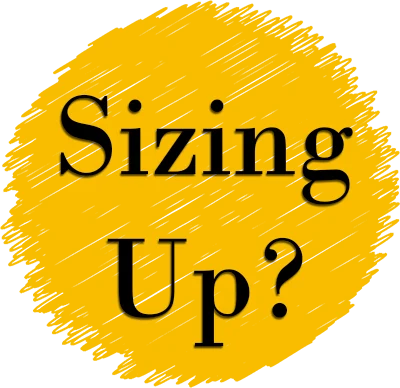
Mountain bikes grow in length (reach) and in height (stack) with each frame size. But modern mountain bikes grow more in length (reach), which is why this is a more important measurement to consider.
Assume you are in between two sizes and you decide to size up. You’ll get a bike with a longer top tube and a longer wheelbase, which means your handlebar will be further away from the saddle.
How does this affect the factors we’ve mentioned above?
Flexibility: This is a good option for riders who are flexible and can easily reach their toes when bent over. A longer top tube means you will need to hinge more at the hips, which can be painful and uncomfortable if you’re stiff and have a short range of motion.
Leg-to-torso length ratio: If you have short legs and a long torso, you should size up when buying a mountain bike as this will give you a more neutral fit. But make sure that the standover height is not too high so that you can’t stand over the bike comfortably.
Riding style: Finally, a larger frame size translates to a longer wheelbase, which means the bike will be more stable on rough terrain and go over obstacles with more ease, but it will feel less playful and more difficult to maneuver.
When to Size Down?
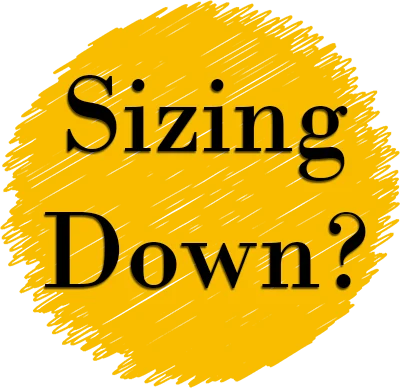
Similarly, a smaller mountain bike will have a significantly shorter reach and a slightly shorter stack and wheelbase. A smaller bike will also have a shorter maximum seat post height, so you may need to extend it depending on how long your legs are.
So how does this relate to the three most important factors mentioned above?
Flexibility: If you are not a flexible person and you struggle to reach your toes with your fingers, then you’ll benefit from a shorter reach a smaller mountain bike frame size offers. It will put you in a more upright riding position, with handlebars closer to your body, which means you can ride for longer without experiencing discomfort.
Leg-to-torso length ratio: Sizing down is a logical choice for riders who have longer legs and shorter torsos. This way, the bike will feel more comfortable, but you may need to use a longer seat post to get the proper leg extension.
Riding style: A smaller mountain bike with a shorter wheelbase will feel more nimble, playful, and easier to handle over rough terrain. If you like flicking your rear wheel and going around obstacles instead of plowing through them, a smaller bike is the right choice.
What If I Still Got the Wrong Bike Size?
Sometimes, even after going through all the methods and consulting several mountain bike size charts, you may find that the bike doesn’t feel right and that you’ve probably chosen the wrong bike size.
Don’t worry, if you’re off by one size or even half a size, there are easy fixes you can try to improve the comfort and fit!
The first thing to do is to contact the retailer/manufacturer and try to get a replacement. Under the right conditions, you’ll be able to get a different frame size bike without significant additional costs.
If you don’t want to go through the hassle of shipping the bike or this option is not available, you can try the following things:
- Adjust the fore-aft position of the saddle: The fore-aft position of the saddle can be adjusted slightly to lengthen or shorten the reach. Make sure not to overdo it so your knee doesn’t end up too far in front or behind the middle of your foot when in the 3 o’clock position.
- Replace the stem: By using a longer or a shorter stem, you’ll be able to increase or shorten the reach by a few centimeters. In most cases, this will be enough to significantly improve the feel and ride quality.
- Replace the seat post: If you bought a bike that is too small and you can’t extend the leg fully when pedaling, consider using a longer seat post.
- Replace the handlebar: A shorter handlebar will be easier to reach and will put you in a less stretched-out position and vice-versa. If you’re using drop bars, consider getting a model with a shorter or longer reach to fine-tune your fitment.
- Raise the handlebar: You can easily achieve a more upright riding position and increase the stack measurement by raising the handlebar with headset spacers. If there are headset spacers above your stem, simply move them underneath to move the stem and handlebar higher up.
- Get a professional bike fitting: A professional bike fitter can do all of these steps for you, which is the best option you have, but also the costliest.
Most importantly, give yourself time to get accustomed to your new bike. Sometimes, your body needs a few days or weeks to adjust to the new riding position.
I remember when I got my first 29er mountain bike. It felt huge and I found it difficult to ride it on narrow winding trails and on technical terrain. However, now that I’m used to the 29er, the 26″ mountain bike seems almost comically small.
Mountain Bike Reviews
Are you in the market for a new mountain bike? Start with one of our mountain bike buying guides below:


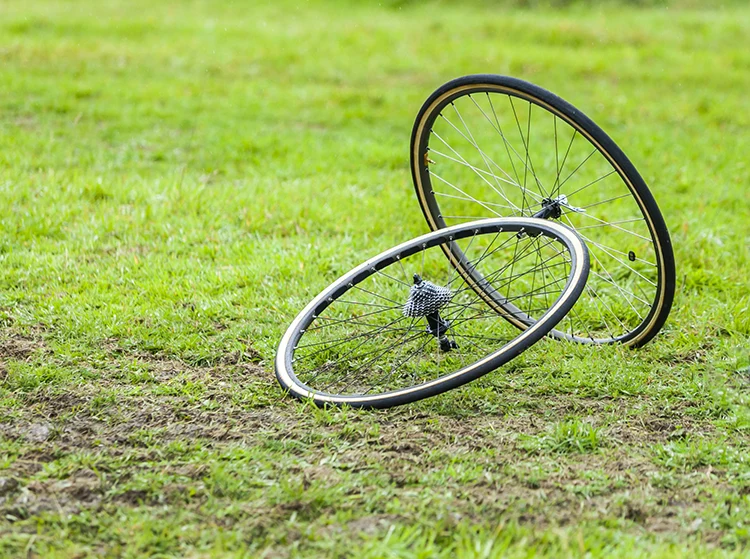
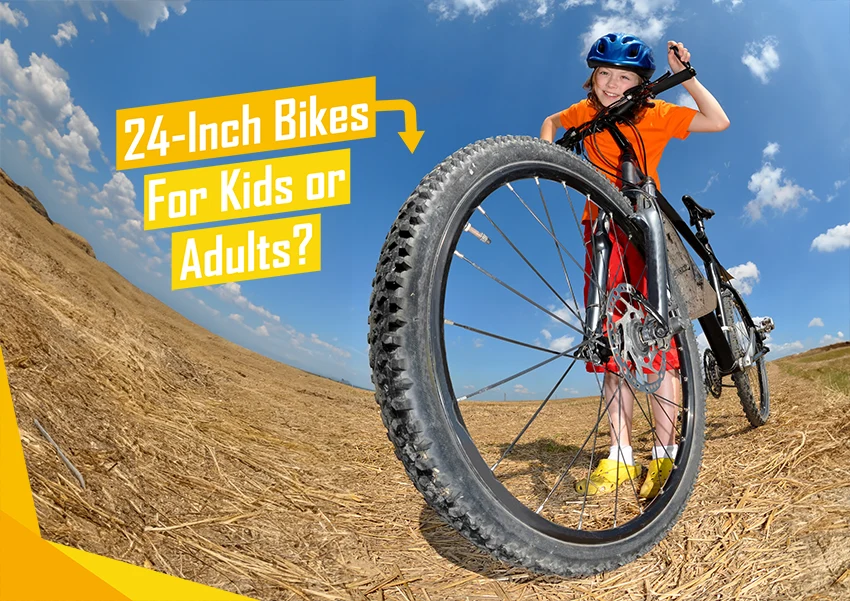
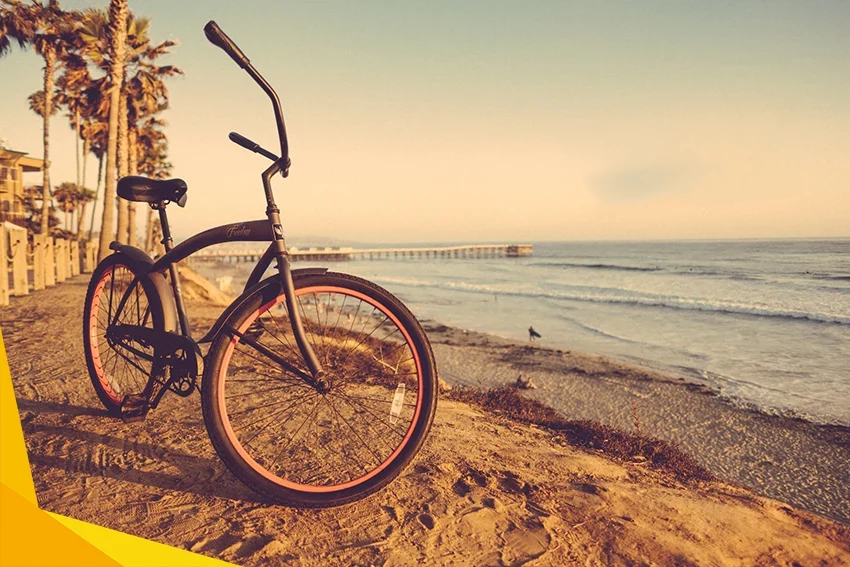
Hi Jeff,
Thanks for your article. I am thinking of purchasing online a Rocky Mountain Vertex Carbon 70 2018 17″/medium.
I am 5’11 and 32″ inseam. I have a road bike that is 56cm but I have to have a really short stem. I have a cyclo that is 54, and feel better at downsizing. I am 50 and so don’t want a bike with a super-aggressive reach.
So you think the m will fit me? Maybe with a longer stem? Thanks, Mark
Hi Mark,
56 is too big for you. The range of sizes for you are 48 – 52 cm frame. These fall under the “large” category. Medium will cause discomfort. Remember that other factors like seat fore & aft, height, stem length etc can influence your riding comfort.
I Jeff, I’m having trouble finding a good fit mountain bike. I am a Mom 5’2”. I was told 24” tire would be good for me – but confused which frame size and some of the 24s I see come up as youth. Does the youth vs adult matter when looking? Also I just tried 2 yesterday, but my knees felt too close to front for clearance … appreciate any recommendations !!
Hi Michelle,
As year go by, mountain bike trend also evolves. Now, people go with 27′ as THE standard as opposed to the 26.’ Your height falls under the 38 – 42 Small category. Please read my post regarding Mountain Bike Sizing chart here: Mountain Bike Size Chart
Hi Jeff,
My 9 yr old has really gotten in to trail riding. I have been riding a 24″ hybrid and it is killing me! I ordered a Mongoose Impasse, 29″ wheels/18″ frame. I’m 6’3″, 228 lbs, 35″ (crotch to floor, bare feet). Please tell me this bike will fit me!!
It should fit you decently well for some shorter rides, but if you decide to ride it for longer, you might have to tweak the position a bit to get more comfortable. 🙂
Hi Jeff. Please help me with the following situation. I have two young daughters that I want to purchase mountain bikes for. They have been out on light trails and are really interested in pursuing this further so I want to purchase them either a Specialized Pitch 27.5 (what my wife rides) or a Specialized Rockhopper 27.5 (what I ride in the 29er version).
They are still young but they are tall. I am 6’4″ and my wife is 5’8″. My daughters are currently 11 years old and 12 and a half years old so they will grow more in the next few years but I am hoping to not have to buy new bikes again if I don’t have to.
What size bikes do you recommend? Also do you have any advice as to which may be better for them the Pitch or the Rockhopper? And finally would it really make a difference for them if they get a men’s bike versus a women’s bike if the stand over height is good for them?
They have long legs like me. I have a 34″ inseam The 11 y.o. is 5’1″ with a 29″ inseam. Based on method #1 height she requires a 13″-16″. Based on method #2 she needs a 19″ and based on method #3 it would be an x-small, or 13″-15″. From what I gather she may be at a Specialized small, but is close to a medium.
The 12 y.o. is five 5’5″ with a 31″ inseam. Based on method #1 height she requires a 15″-17″ or 16″-17″ based on inseam. Based on method #2 she needs a 20″ and based on method #3 it would be a small, or 15″-16″, but is an inch in height away from a medium or 16″-17″.
When they get on my wife’s medium men’s pitch 27.5 with the saddle adjusted as shown on your site, they can both stand over it and my 11 y.o. feels good except she thinks the handle bars are a bit to far forward for her. My 12 y.o. says she feels good on it but feels it’s a bit too small for her legs.
I was originally thinking of purchasing a medium and a large. Hope you can help sort all this out. Thank you in advance for your time!
Hey Joseph, it’s very difficult to choose the right size for kids at that age, because as you mentioned, they will grow more in the future and you wouldn’t like to have to buy new bikes again soon. Still, you can’t buy a bike that’s too big because they wouldn’t be able to enjoy them right now.
The difference between the Rockhopper and the Pitch is minimal, so either one would be a good choice — whichever they like better, basically. 🙂
As for the size, they’re lucky they can try your bikes, so you can choose the size based on that. I think you’ve already answered your questions, actually.
You can tweak the Pitch by installing a shorter handlebar, which would technically shorten the reach a bit for your daughter. As for the Large frame, it seems a bit too big for a 5’5″ rider, but if you can tweak it a bit and you expect your daughter to grow a few inches soon, you can go for it. 🙂
Hi Jeff,
I want to buy the remedy 9.7 from trek. I am a roadie and I ride a 52cm. I am 5’7 but with short legs, 28.4 inseam. I did a lot of research and thinking and I think if the bike existed I am a 16-inch frame. The issue I have is that, the remedy only comes in 15.5 or 17.5. So basically in road terms I am between a 50cm and a 54cm, and I know one is too small and the other is too big. I have been saving for that bike for a while and I now have to pick from the 15.5 or the 17.5. What would you do? Other info, I am a climber (5’7, 150 pounds) on the road. I am cat 3. I am getting the remedy to basically do XC events and I picked the remedy because I hope the geometry helps build confidence descending, I also want to try some mini jumps. I am in my 30’s and never did anything crazy so I mostly would ride the bike as an XC bike.
Hi Miguel, I’d go for a 17.5″ size frame, I think a 15.5″ frame would be too small for you. With shoes on, the standover clearance will be just right as well. You can also try to compare the stack and reach measurements on your road bike with Trek Remedy and see whether the 15.5″ or 17.5″ frame is more similar to it in this regard. Good luck!
I found this helpful! But still could use a bit of help if you’re up to it! I’m 5’10” and mostly limbs (34″ inseam) I got a cruiser off Craigslist and changed out the seat and handlebars and while it’s more comfortable it’s not fantastic. My roommate also got a cruiser and his is fantastic.. the reach is 4″ longer than mine and it’s what I need. But I’m not totally sure how to go about finding a bike with that- I know most/all your info is for road and mountain bike so forgive me if cruisers are totally different and out of your wheelhouse. I’ve been up and down the internet and feel a bit defeated 🙁
Hi Pj, all you need to do is measure your roommate’s bike’s reach and find a bike with the same reach. 🙂 You have some excellent tutorials on YouTube on how to do that, so check them out. You can usually find the reach of the bike in the geometry charts.
What would I do in my case I am 4’9″ I just miss the XSmall frame size? Is there such a thing as an Xtra Xtra Small? Or would I have to go to the Boys or Girls Bikes?
Hi Christina, yes, some bikes come in size XXS. One example is Co-op Cycles DRT 1.0. We wrote about it here if you want to check it out. 🙂
Good day. I am planning to buy a trail bike (haven’t ridden since my teens). If I measured correctly using the inseam method you suggest, my ground up to crotch is 30″ (no shoes) and 31″ (with shoes). I’m a male, 5 ft. 5.5 inches +/-. If I did the math correctly in your article, it seems I would need a Large frame based on my inseam measurements? My neighbor, who is a hard core cyclist, suggested that I need a small frame. I am considering the REI Co-Op Cycle DRT 1.1 or 1.2 in a small frame (https://www.rei.com/CompareProduct/User). Any guidance? Thank you so much, and sorry for my lack of knowledge in this area.
Yes, a small frame would be a good choice for you, you should use several methods and consider several factors when deciding on the size of the frame. 🙂
Hi Jeff,
I am 5’9″tall woman, inseam 33″. Just purchased 18″ mountain bike with 29″ wheels. Still questioning myself if I didn’t buy a small bike. I took it for a ride and my wrists and low back were uncomfortable/hurting.
Lastly, the handlebars are 32″ wide. Is there a recommendation for a handlebar width?
Thank you in advance!
Hey Jana, that bike should not be too small for you according to most charts and projections. Those handlebars could very well be the culprit, they might be stretching you out too much. I’d try with a narrower one.
Hello, I’m 5’9 and about 3/4 my inseam is measuring between 88cm and 89cm. I found a 26in’ women’s MGX mountain bike online.
I really need a bike for the trails and riding around with my daughter I’m so confused. Is that bike an ideal size for me?
Hi Tamia. 26″ refers to the size of the wheels. You need a bike with an 18″ size frame. The wheels can be 26″, 27.5″, or 29″. But I recommend 27.5″ wheels.